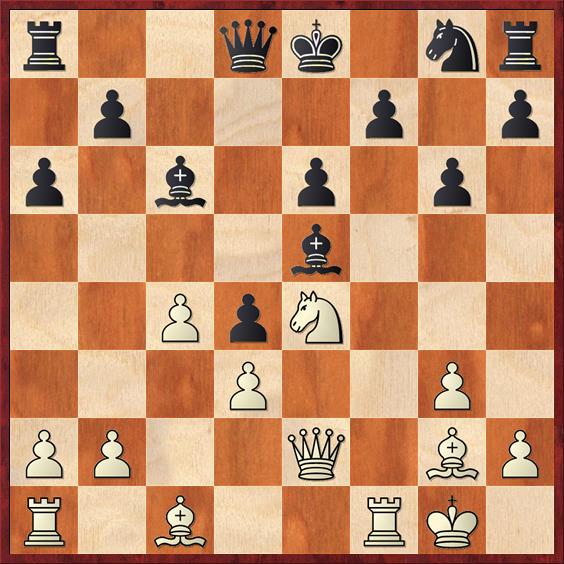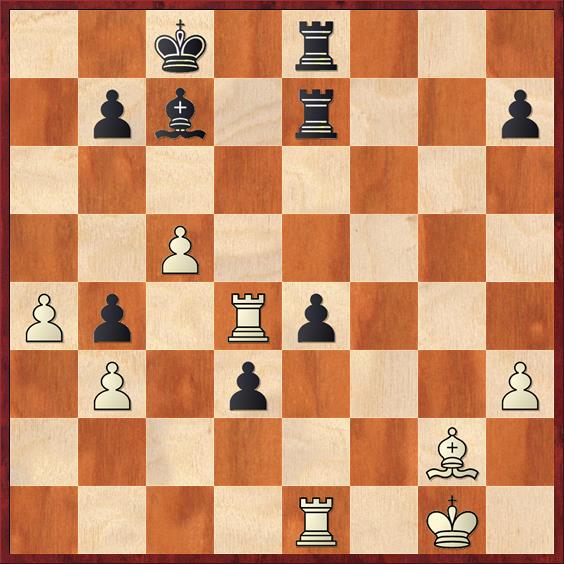Alas, this weekend I am not playing in what is usually my favorite tournament of the year, the Western States Open in Reno. I could give you a complicated explanation, but the simple explanation is family reasons. So I’m stuck at home with nobody to play but my computer.
You know what that means… Matrix chess!
To catch up the uninitiated, the rules are that I play against the computer at game/10, and I am allowed one timeout of unlimited length.
So here’s an entertaining but highly flawed game that I played against Shredder this morning. In this game, the computer is set to a strength of 2201. (Whatever that means.)
I botched the opening as Black, Shredder played an ambitious pawn sacrifice, and we reached the following position. Even though it’s only move 14, I felt as if I was balancing on the edge of a precipice and this would be a good time to call my time-out. I was right.
 Position after 14. Qe2. Black to move.
Position after 14. Qe2. Black to move.
FEN: r2qk1nr/1p3p1p/p1b1p1p1/4b3/2PpN3/3P2P1/PP2Q1BP/R1B2RK1 b kq – 0 14
Questions:
- What should Black play here?
- What is wrong with 14. … Bg7?
- What is wrong with 14. … f6?
Okay, obviously Black doesn’t have a great position, and no matter what I do I’m going to have to defend. It’s been said that to be a good defender you need just as good tactical awareness as you need to be a good attacker. Here is a position that definitely proves that saying is true.
One of my first candidate moves was 14. … Bg7. Black calmly gets his bishop out of the way of the discovered attack, shores up his dark-square weaknesses, and asks White, “So what are you going to do about it?”
The trouble is that the rope-a-dope doesn’t work here. White smashes through with 14. … Bg7 15. Rxf7!! and after 15. … Kxf7 16. Ng5+ Ke8 17. Qxe6+, it’s all over. If 17. … Qe7 18. Bxc6+ and White will win the rook on a8.
Whew! Good thing I saw that.
Another move that I looked at for quite a long time — in fact, I was almost ready to play it — was 14. … f6. I couldn’t find a clear way for White to win after 15. Ng5, when of course I don’t take the knight but instead I hunker down with 15. … Bxg2! 16. Kxg2 (he doesn’t have time to take on e6 because of … Bxf1) Qc7 and White still can’t take on e6 because of 17. … Qc6+. Also, on 15. Nc5 I was prepared to return the pawn for a playable endgame with 15. … Bxg2 16. Qxg2 Qb6 17. Qxb7 Qxb7 18. Nxb7.
But suddenly I realized that White doesn’t have to dance around trying to win the e6 or b7 pawns with his knight. He can go postal with 14. … f6 15. Nxf6+!! Bxf6 16. Qxe6+. Once again, the queen on e6 is terrifying, and the little tactical trick of Bxc6+ followed by Qxc6+ winning a rook is back in play. And if Black tries to step aside with 16. … Kf8 White has the exquisite finish, 17. Rxf6+!! Qxf6 (or 17. … Nxf6 18. Bh6 mate!) 18. Bh6+ and White wins Black’s queen with an overwhelming advantage.
Whew again!
So after I saw these two lines it was pretty obvious to me what I should do. The two huge weaknesses in my position are the pawn on f7 and the pawn on e6. They must be defended right away. Also, I need to have some response to White’s threats of Nc5 or Ng5, discovering an attack on my bishop. The move 14. … Qe7! looked like a good all-purpose move. It indirectly defends the bishop, protects f7 and e6, and prepares to castle long. So that’s what I played. Shredder played 15. Ng5 and I played 15. … Bf6. Shredder couldn’t find a way to make progress and played 16. Ne4. I briefly toyed with the idea of 15. … Bg7, but I couldn’t resist going back to the diagrammed position with 16. … Be5 to see if Shredder could come up with anything else. It finally played 17. b3, after which White is still better but I felt I had survived the immediate crisis.
Many, many, many mistakes later (by both sides) we got to an interesting endgame position.
 Position after 45. … fe. White to move.
Position after 45. … fe. White to move.
FEN: 2k1r3/1pb1r2p/8/2P5/Pp1Rp3/1P1p3P/6B1/4R1K1 w – – 0 46
Questions:
- What is the right way for White to recapture on e4?
- What is wrong with 46. Rdxe4?
- What is wrong with 46. Bxe4?
Well, if you read questions 2 and 3 you already know the answer to question 1. The right way to capture is 46. R1xe4, after which the game peters out quickly into a draw.
46. Rdxe4? fails to a neat trick: 46. … d2! when 47. Rxe7 deQ+! is a cool X-ray attack.
To my shock, Shredder played 46. Bxe4?, which is also bad. But maybe not quite for the reason you’d expect! At first I wanted to play 46. … d2, as in the last line, but finally I figured out Shredder’s idea: 47. Bf5+! followed by trading on e7 and taking on d2.
Darn that clever computer! But then I realize that if I just step out of the check in advance, White’s bishop is still pinned and even with an extra move, he can do nothing about the threat of d2! So I played 46. … Kb8!! 47. Kg2 d2 48. Rxd2 Rxe4 and eventually won.
You might be surprised at the computer missing a tactical trick like this, but Shredder does sometimes miss stuff when it’s “dumbed down” to 2201.
This was definitely a game won with defense, both early in the game and late. And in both cases, the key to a successful defense was to be just as tactically alert as the attacker. (Or even more so.)


